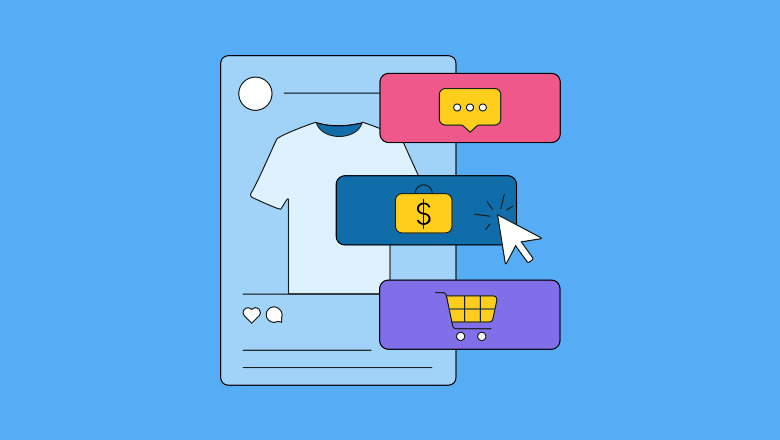Social Shopping in 2022: Platforms, Tips and Predictions

It takes just one click to start a relationship between a consumer and your brand. Social shopping combines online culture and the world of e-commerce—and it’s not going anywhere. More than a third of consumers expect their social use to purchase products and services to increase by 2024.
There is no time like the present to reach out to the consumers through social media. Thanks to social shopping, businesses can begin to demonstrate the bottom line, revenue impact of that reach.
In this article, we will explore:
- What is social shopping and why it’s huge for brands
- different types of social shopping
- A roundup of expert predictions for social shopping in 2022
What is social shopping?
Social shopping is the amalgamation of social media and online shopping. Users make purchases from social media platforms such as Facebook, Instagram and Pinterest, either in the app itself or after clicking on a product web page.
Social platforms mimic the personal experience of browsing in physical malls and stores with technologies such as group shopping, messaging and interactive content.
Social shopping focuses the consumer’s touch points with a brand in a single place, from discovery and engagement to actual purchases. It’s a convenient way to meet consumers where they are, turning browsers into buyers.
What does social media shopping do for brands?
Social shopping is a win-win for brands and consumers. Buying is not an isolated incident. In many cases, consumers can make purchases without leaving their chosen platform. Both consumers and brands benefit from the reach and interaction opportunities social media offers. Other benefits include:
- It removes friction and increases conversion. Buyers do not need to leave the comfort of their home, office or commute, nor do they need to talk with multiple salespeople to buy from a single brand. They don’t even need to leave the social media platform they are running. In just a few clicks, buyers can access the product page and proceed to purchase.
- You can incorporate social proof into campaigns. Customer reviews are one of the most influential sources on purchasing decisions. Social shopping makes it easy for consumers to buy your product and share authentic feedback all in one place. Even better, you can incorporate this social proof into your future marketing campaigns for added credibility.
- You’ll have better data on what works. The more time consumers spend on and buy from Social, the more Social becomes a storehouse of insights about your target audience. With the right tools, you can quickly find actionable information to better serve your consumers. For example, Sprout makes it easy to identify what types of social content convert best and monitor conversations about your brand in a single view.
examples of social shopping
There are already many forms of social media shopping (with more to come as the technology evolves).
social commerce
Social shopping is quite synonymous with buying and selling goods through social commerce or social media platforms. Around 8 in 10 businesses are projected to sell products or services through social media platforms by 2024.
One brand with a strong social presence is DPHUE, a hair care brand. Consumers can swipe through Instagram Stories that highlights its individual products, then browse the brand’s Instagram shop to purchase a range of products without leaving the app.
bulk shopping
Group shopping occurs when several people show interest in or buy a product at once. Peer-to-peer connection drives the experience: According to Sprout research, friends’ recommendations are the most influential factor on consumers’ social purchasing decisions.
This method is popular in Eastern countries but is still nascent in America. Squaded and Supergreat are two brands that offer collaborative shopping experiences. They are niche communities that allow users to connect with groups of friends and shop together. Users can ask each other for advice about specific products, and share verified reviews.
conversational commerce
Conversational commerce is when merchants and consumers engage in real time through platforms such as messaging apps and chatbots. It lets brands create a more personalized digital experience, whether it’s clarifying questions about an order or recommending specific products to buy.
Livestream and Virtual Shopping
With livestream purchases, brands can create their own digital QVC—without long hold times or rate charges. You can reach new audiences and show consumers a glimpse of your products.
In 2021, Walmart partnered with TikTok to provide a shoppable livestream experience. Tiktok users could make purchases from Walmart directly from the app. Walmart earned seven times its estimate and grew its TikTok userbase by 25%. Poshmark’s “posh parties” are another example of a successful virtual live event. During these parties, users can interact with other shoppers, view over 200 million items for sale, and see which brands are trending.
AR commerce
Augmented Reality (AR) commerce uses 3D mapping technology to allow shoppers to try or interact with a product before buying it. The experience can be as small as trying on clothes and as big as entering a virtual “store”. One company to go all-in on AR is L’Oréal, which acquired its AR firm in 2018. It has since given shoppers the ability to try out hair and makeup colors on their brand’s Instagram Shops before shopping.
3 biggest social shopping platforms right now
Facebook Shops
More than 250 million users and 1 million sellers actively use Facebook Shop every month. Other meta apps like WhatsApp and Messenger are convenient for supporting the buyer journey and answering questions about specific products.
Instagram Shopping
Instagram’s focus on visual content naturally lends itself to a retail experience, which is why 41% of consumers say they are most likely to shop from the platform. Instagram Shopping connects users to products and purchases with just one swipe.
Thanks to integration with Shopify, millions of merchants can turn their inventory on Pinterest into shoppable product pins—but it’s just one of the platform’s latest forays into commerce.
From adding AR capabilities on beauty pins to launching a Pinterest TV shoppable livestream, the platform intends to create a more seamless consumer experience.
…and don’t forget tiktok
Tiktok shopping is coming soon. Given that users are 1.7 times more likely to buy something they find on the app, its potential for purchases and consumer connections is huge.
Amy Stamper, Paid Social Lead at UK-based digital marketing agency Impress, says, “TikTok’s ongoing growth and monetization opportunities have helped propel products forward – from leggings to cleaning products and everything in between. something.” “In 2022, TikTok will continue to make products go viral, but much of it will be driven by ads and brands now waking up to the power of TikTok.”
What’s Next for Social Shopping, According to Experts
Curious what next year has in store for social shopping? We talked to several experts to see what we should expect in the coming months.
shopping gets personal
“Macro trends-based, personalized shopping will fuel the social commerce experience,” says Meghan Salgado, Associate Growth Manager, Poshmark. “We will continue to broaden our reach by meeting consumers where they are – whether on our own platform or by integrating with others. This integration will take place more directly in social content with a focus on seamless shopping.”
conversation is king
“I think 2022 will see growth in not only social commerce but conversational commerce,” says Ian Leslie, senior director of retail advocacy at checkout experience platform Bolt. “Brands will continue to invest in channels and technology that not only allow them to interact socially with their customers but help them work their way through the funnel to checkout.”
Checkout becomes easy
“We will see better integration and less friction across the purchase funnel,” says Alessandro Bogliari, co-founder and CEO of The Influencer Marketing Factory. “And thanks to new payment integrations and the ability to save billing and shipping information, users will be able to easily pay for anything with a single click, regardless of the platform they’re buying on.”
Peer proof sells
“We know that most shoppers trust others’ reviews of products,” says Stephanie Gutierrez, senior social media strategist at online Optimism, a digital marketing and design agency. “With this in mind, we can also expect platforms like Instagram to take advantage of their photo and video-sharing capabilities to allow users to turn their content into reviews.”
Prepare for the future of social shopping
Consumers want richer, easier and faster ways to shop. Social shopping works on all three fronts.
Want to level up your brand’s social shopping efforts? Learn about our new research influencing consumers’ decisions to shop on social.
Social shopping posts in 2022: Platform, tips and predictions first appeared on Sprout Social.





